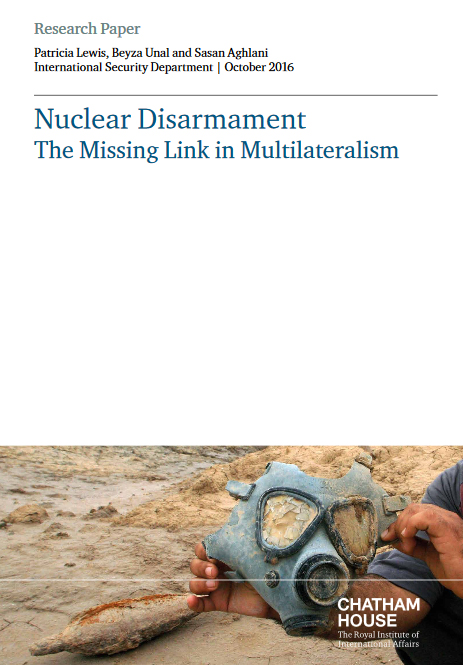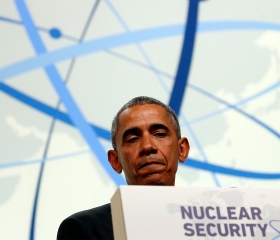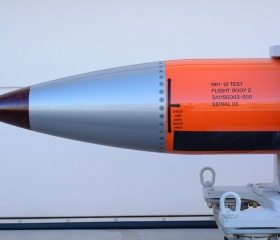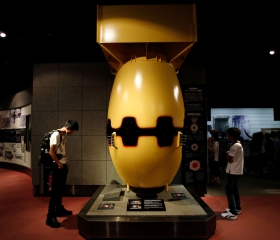Global Development and Nuclear Weapons
Chain Reaction Peace Sculpture showing
a atomic bomb mushroom cloud was designed
by Paul Conrad in 1991, Santa Monica,
California, USA
(no votes) |
(0 votes) |
Research Fellow at the Center for International Security, Institute of World Economy and International Relations of the Russian Academy of Sciences, co-founder of the Vatfor project, RIAC Expert
A study conducted by the Chatham House on the relationship between problems concerning nuclear weapons (NW) and other issues of multilateral international cooperation published in October 2016 finds there is common ground between the traditional approaches to nuclear disarmament and the “humanitarian” views calling for the complete and immediate prohibition of nuclear weapons.
A study conducted by the Chatham House on the relationship between problems concerning nuclear weapons (NW) and other issues of multilateral international cooperation published in October 2016 finds there is common ground between the traditional approaches to nuclear disarmament and the “humanitarian” views calling for the complete and immediate prohibition of nuclear weapons.
View from London
On 12 October 2016, the Royal Institute of International Affairs, better known as the Chatham House, published its latest study on the relationship between problems concerning NW and other issues of multilateral international cooperation.
It should be noted that with the involvement of the same expert, Director of Research Dr Patricia M. Lewis, a series of materials was prepared to promote the fight against NW as such in the context of the catastrophic effects of their use, including the limited or erroneous use. In particular, in 2014 a report was presented for the court of public opinion about situations similar to the use of NW and the potential political decisions to minimise them (in particular an increase in the timeframe for making decisions on the use of NW; confidence-building measures; collective decision-making during crises and raising awareness about the consequences of using NW), and in 2015 a study was conducted on issues concerning the humanitarian dimension of the problem of NW with the active participation of non-nuclear powers and civil society.
In the study in question, the authors conclude that NW present an insurmountable risk to health, development, climate, social structures and human rights on a global scale. The accidental or intentional use of NW would lead to catastrophic consequences both at the site of the explosion as well as in other parts of the world, including in the long-term. The authors call on the international community to mutually link all of these issues into a coherent multilateral approach at the highest level while attaching primary importance to the safety of mankind and the “survival of the species”.
It is correctly noted that experts and officials working in these areas are not always aware of all the special aspects and consequences of using NW. In addition, three trends are highlighted that negatively affect the effectiveness of studying this problem:
the general confidence that the risks associated with NW are currently lower than they were during the Cold War years;
the view about the lack of need to pay significant attention to nuclear disarmament, which is proceeding as usual;
a loss of interest in connections between nuclear disarmament and sustainable progress of mankind
Related problems and missing links
Specialists from the International Security Department considered the impact of a potential NW detonation on a number of topical problems facing the global community, specifically:
- Climate change
- Development
- International law
- Gender issues
- Protection of cultural monuments
- Healthcare
- Dissident armed forces
- Humanitarian activities
- Cybersecurity
Let’s have a more detailed look at the related problems specified by the authors.
1. An expert climate study from 2014 notes the catastrophic nature of even a limited nuclear war in Asia (roughly a hundred nuclear warheads with capacity of 15 kilotons) for the environment and climate on a global scale and in the long-term, including with the an irreparable impact on agriculture in China and the U.S. Thus, all the efforts made by the international community in fighting climate change, including the Paris Agreement, would instantaneously be undone. Experts on climate, nuclear weapons and international need to cooperate to study the following issues: the “immersion” of environmental standards into international humanitarian law; the use of multilateral environmental protection agreements in the framework of a conflict; the designation of NW as an integrated controlled system that pollutes the environment during production, deployment and use.
2. Noting the effective achievement of the development goals contained in the UN Millennium Declaration and presenting a brief description of the Agenda for sustainable development over the period until 2030, experts note there is a link between future results and as those that have already been achieved with nuclear weapons as well as with the problem of nuclear disarmament as a whole. In particular, they note that enormous resources (which could be redirected towards addressing development challenges) spent on:
- reservists and the medical corps in the event of a nuclear attack on troops,
- the production and storage of nuclear warheads,
- the development, production and operation of delivery systems,
- maintaining control systems.
Moreover, the redistribution of limited resources within the government in favour of NW could lead to lower living standards and a general increase in tension. As a curious example of “harmful” priorities, the authors cite the need to take into account the possibility of terrorist attacks using nuclear weapons during the preparation of large-scale international events (for instance, the World Cup) as well as the development of corresponding response plans and the distribution of resources.
3. In terms of international law, there is a contradiction in the actual existence of NW and the ability to use them with UN goals and objectives as well as their fundamental inclusion under the Geneva Protocol of 1925 and other international agreements. The UN General Assembly, Review Conference of the Parties to the Treaty on the Non-Proliferation of Nuclear Weapons and the International Court of Justice continue to debate the fundamental designation of NW as “illegal”. At present, it is believed that the standards of international humanitarian law are fully applicable to NW (which is interesting taking into account the obvious indiscriminate nature and long-term consequences of nuclear strikes), however the International Court of Justice has not ruled out the admissibility (“legality”) of using NW “in extreme cases of self-defence”. The study authors believe that problems in international law need to be corrected to ensure the control and destruction of NW.
4. A study of the impact of using NW, above all radiation, indicates there would be a greater risk for cancer among women compared with men, which given the female population’s role in the reproductive process would lead to long-term consequences for humanity as a whole. Given the fundamental emphasis on gender equality, including in contemporary international relations and sustainable development goals, experts have followed the lead of the UN General Assembly and called for ensuring women are involved in the disarmament processes at the international and national levels.
5. The consequences of using NW in the context of preserving cultural values do not require a detailed examination, however the ability to involve the relevant experts in the debate should not be underestimated. The risk of turning any site into an exchange of emotional accusations is rather high, however in the future countries with nuclear weapons could reach multilateral agreements concerning the deployment of forces and systems as well as the selection of targets taking into account the maximum preservation of mankind’s cultural heritage. It should be noted that there is a high probability of abuses in this area.
6. As regards the healthcare system, the authors use “broad strokes” to point out the catastrophic short-, medium- and long-term consequences of a nuclear exchange, including for territories that are not directly affected. In particular, they stress problems with water supply, deterioration in the epidemiological situation, a decrease in crop yields, famine and related diseases. The study authors believe that cooperation among expert communities in healthcare and nuclear disarmament could help to get a full picture of the consequences of using NW in the context of mass health.
7. The chance of a nuclear device falling into the hands of a dissident armed group remains one of the most terrifying threats of our time, and it’s impossible to not agree with the authors in that regard. However, highly significant results have been achieved in this regard both at the national and international levels. Credit should be given to the Nuclear Security Summits held under the patronage and at the initiative of U.S. President Barack Obama as well as international attention to the problem of the safekeeping of nuclear facilities and materials in the former Soviet Union. In the future, the main problems may be a waning interest in this area, which can already be seen using the example of the U.S. election campaign, as well as the continued non-transparency of nuclear arsenals among “small” nuclear powers. In addition, the existence of U.S. nuclear bombs in European countries should also be remembered, including the “success story” of those fighting against NW at Kleine Brogel Air Base in Belgium in 2010.
8. In addition to the obvious unsolvable problem of prohibiting NW in the foreseeable future, organisations involved in humanitarian missions pay serious attention to studying the approaches used to render aid to victims of a nuclear strike. In particular, they assess the scale and areas of migration flows, typical wounds and diseases as well as the consequences of destroying transport, medical, communications and financial infrastructure. The professional consideration of these issues involving representatives of nuclear powers could serve to improve the sustainability of critical infrastructure and reduce the consequences of using NW for civilians as well as the overall systematisation of available data concerning protecting the population against modern weapons.
9. The relationship between the nuclear sector and cybersecurity is on the agenda of all key research centres, state-owned organisations and international platforms. One of the key problems is the attribution of an attack in cyberspace, i.e. in the event of an attack on nuclear weapons complex facilities, the control system or other related infrastructure it would be virtually impossible to quickly determine not only the direct source of the attack, but its government or non-government affiliation.
At the same time, it should be stressed that awareness about a potential cyberattack by a “likely enemy” clearly leads to more intensified security of the NW control networks against acts of illegal interference by non-government actors. A constructive debate needs to be held both among nuclear and non-nuclear powers. If the concerned parties are willing to have a substantive discussion of this problem, much attention should be paid to the “platform” for this work in order to avoid a conflict between the “nuclear”, “disarmament” and “IT” agencies and organisations.
Russia’s strategic approach

Mikhail Troitskiy:
The Nuclear Factor in Global Politics: Myths
and Reality
Russia is traditionally sceptical of initiatives for a “complete ban” on NW and removing this problem from the overall context of international military and political relations. This was reaffirmed as part of Russia’s official position at the 71st session of the UN General Assembly.
It should be emphasised that Russia and the U.S. are the ones who strengthened nuclear security within the framework of bilateral agreements by eliminating an entire class of weapons (INF Treaty) as well as a consistent parity-based reduction in strategic weapons (START). The role of transparency and confidence-building achieved during the implementation of these agreements must also be mentioned. In general, according to an assessment by Mikhail Ulyanov, the director of the Non-Proliferation and Arms Control Affairs Department under the Russian Ministry of Foreign Affairs as well as the Russian Federation’s representative on the First Committee of the 71st session of the UN General Assembly, within the framework of the general political debate the reduction in Russia’s strategic nuclear forces compared with the peak levels is as high as 85%, while tactical NW (1/4 of the existing arsenal) have been put into a non-deployed state. Incidentally, the debate within the First Committee is extremely heated and may serve as a vivid illustration of the problems concerning mutual understanding and the pent-up contradictions in bilateral and multilateral relations, which hinders effective disarmament.
The theme of nuclear weapons was also addressed at a plenary session of the eighth annual meeting of the Valdai International Discussion Club: Russian President Vladimir Putin commented on the role of NW as a factor that ensures global peace and security as well as the catastrophic nature of the consequences of using NW as a weapon of aggression.
Denuclearisation or security?
To date, to get rid of NW, the proper conditions have not been created, and given the current level of international tensions this prospect does not appear to be realistic in the foreseeable future. Perhaps the best scenario could be the establishment of common, global views on the problem of strategic stability in bilateral and multilateral relations, a common understanding of the stabilising and destabilising nature of particular technical and organisational measures as well as growth in transparency, security and trust with respect to the mutual assessment of nuclear arsenals. The situation is considerably complicated by the existence of several conditional groups of nuclear powers – “large”, “small”, “official”, “recognised”, “unrecognized” and so on. Perhaps implementing the measures of the study by the Royal Institute of International Affairs as regards the broad exchange of opinions about the consequences of using NW with the involvement of experts and officials from different fields would make it possible to promote an inclusive dialogue on this matter.
On 27 October 2016, the First Committee of the 71st session of the UN General Assembly adopted several draft General Assembly resolutions directly concerning the problem in question by a majority vote. In particular, the adopted draft resolution on the relationship of NW and humanitarian issues highly resonates with the study conducted by the British experts. However, the greatest interest is in the draft resolution that authorises a UN conference in 2017 to coordinate a legally binding document on the prohibition of NW that would lead to their total elimination. Some experts have already called this an historic event while noting the almost complete lack of interest in it in the U.S.
In this regard, the Russian media, experts and officials have also generally been limited to rather short statements, yet this event may well become a harbinger of fundamental changes to the nuclear landscape. Taking into account Russia’s official position outlined above, Russian experts and diplomats need to hold a qualified debate at the national level in order to form a clear and strong position concerning the legal prohibition of NW, including for the possible use of this initiative in the Russian government’s interests. Such global processes do not take place over night, thus the objective of “traffic control” on the path to eliminating NW (including in accordance with the provisions of the NPT) also includes identifying the priorities of nuclear disarmament, and it is precisely in this area that effective work by official representatives of the Russian Federation is possible. The alternative may be further “nuclear stratification”, which would probably lead to problems in bilateral and multilateral relations on other matters.
In conclusion, I would like to recall a vivid episode from 1945, the period of the start of the Soviet-U.S. standoff and the development of the first plans for a full-scale nuclear conflict: during a discussion of a speculative plan concerning a strike against the USSR and the corresponding nuclear arsenal, Lieutenant General Leslie Groves (the military leader of the “Manhattan Project”) pointed out to Lieutenant General Lauris Norstad (Deputy Chief of the U.S. Air Force General Headquarters) the exaggerated number of atomic bombs required to carry out a strike. According to the military nuclear physicist and also taking into account the experience of Hiroshima and Nagasaki, the objective of destroying the targets specified in the plan could have been effectively met with significantly fewer warheads.
I would prefer not to verify the adequacy of a nuclear weapon’s power estimates regardless of the era they were made in.
(no votes) |
(0 votes) |









